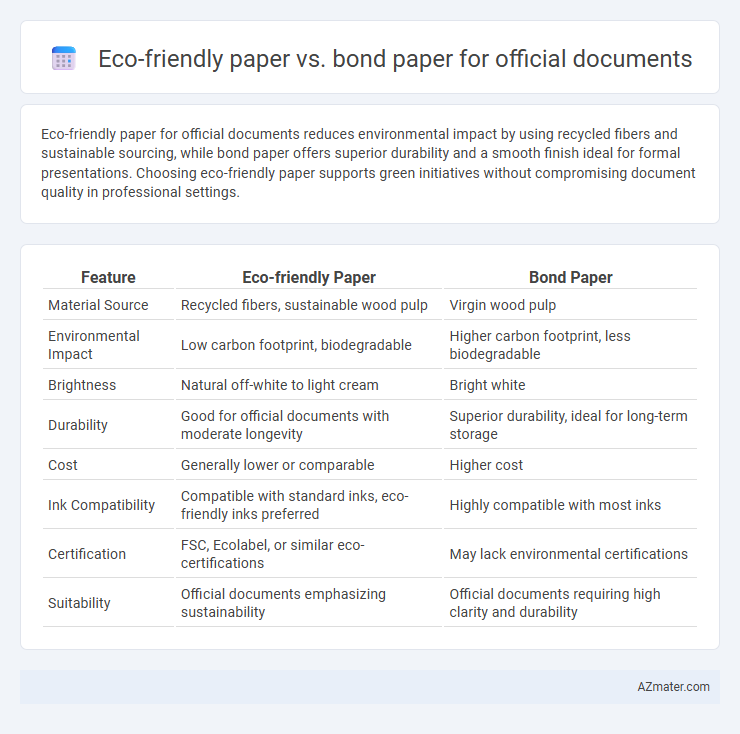Eco-friendly paper for official documents reduces environmental impact by using recycled fibers and sustainable sourcing, while bond paper offers superior durability and a smooth finish ideal for formal presentations. Choosing eco-friendly paper supports green initiatives without compromising document quality in professional settings.
Table of Comparison
| Feature | Eco-friendly Paper | Bond Paper |
|---|---|---|
| Material Source | Recycled fibers, sustainable wood pulp | Virgin wood pulp |
| Environmental Impact | Low carbon footprint, biodegradable | Higher carbon footprint, less biodegradable |
| Brightness | Natural off-white to light cream | Bright white |
| Durability | Good for official documents with moderate longevity | Superior durability, ideal for long-term storage |
| Cost | Generally lower or comparable | Higher cost |
| Ink Compatibility | Compatible with standard inks, eco-friendly inks preferred | Highly compatible with most inks |
| Certification | FSC, Ecolabel, or similar eco-certifications | May lack environmental certifications |
| Suitability | Official documents emphasizing sustainability | Official documents requiring high clarity and durability |
Introduction: Understanding Paper Types for Official Documents
Eco-friendly paper, made from recycled materials or sustainable sources, offers a smaller environmental footprint compared to traditional bond paper, commonly produced from virgin wood pulp. Bond paper is favored for official documents due to its durability, smooth texture, and high opacity, ensuring professional presentation and longevity. Understanding the differences in composition and environmental impact helps organizations choose between sustainability and traditional quality for their official paperwork.
What is Eco-Friendly Paper?
Eco-friendly paper is produced using sustainable materials such as recycled fibers or rapidly renewable resources, reducing environmental impact compared to traditional paper. It typically avoids harmful chemicals like chlorine bleach, instead using eco-friendly bleaching agents to minimize toxic emissions. This type of paper is ideal for official documents requiring both quality and environmental responsibility, promoting sustainability in corporate and governmental practices.
What is Bond Paper?
Bond paper is a high-quality durable paper commonly used for official documents, characterized by its strength, smooth texture, and excellent ink retention. It typically contains cotton fibers, making it resistant to wear and tear, ideal for legal documents, certificates, and letterheads. While bond paper ensures a professional appearance, eco-friendly paper offers a sustainable alternative, often made from recycled materials or FSC-certified sources.
Environmental Impact: Eco-Friendly Paper vs Bond Paper
Eco-friendly paper significantly reduces environmental impact by using recycled fibers and sustainable materials, cutting down deforestation and lowering carbon emissions during production. Bond paper, typically made from virgin wood pulp, involves higher energy consumption and greater waste generation, contributing to environmental degradation. Choosing eco-friendly paper supports responsible forest management and pollution reduction, making it a greener option for official documents.
Quality and Durability Comparison
Eco-friendly paper often features recycled fibers and sustainable production methods, resulting in a slightly rougher texture but sufficient durability for most official documents. Bond paper, typically made from high-quality cotton or wood pulp, offers superior strength, smoothness, and resistance to tearing and aging, making it ideal for long-term archival use. While eco-friendly paper supports environmental goals, bond paper remains the preferred choice for official documents requiring enhanced quality and longevity.
Aesthetic Appeal and Professional Presentation
Eco-friendly paper offers a natural texture and subtle color variations that enhance the tactile and visual appeal of official documents, promoting sustainability without compromising elegance. Bond paper is known for its smooth finish and bright white tone, delivering a crisp, clean look that conveys professionalism and clarity in formal settings. Choosing between the two depends on balancing environmental values with the desired level of visual refinement and paper performance for official presentations.
Cost Analysis: Price Differences and Value
Eco-friendly paper typically costs 10-15% more than bond paper due to sustainable sourcing and manufacturing processes, yet it offers long-term value by reducing environmental impact and improving corporate responsibility. Bond paper remains popular for official documents because of its affordability, averaging $0.02 to $0.05 per sheet, whereas eco-friendly alternatives range from $0.03 to $0.07 per sheet. Investing in eco-friendly paper aligns with green business practices, potentially enhancing brand image and meeting regulatory requirements without compromising document quality.
Printing Compatibility and Performance
Eco-friendly paper offers excellent printing compatibility with most inkjet and laser printers, ensuring sharp text and vibrant colors, while maintaining sustainable attributes such as recycled content and lower environmental impact. Bond paper is designed for high durability and smoothness, providing consistent performance for official documents, especially in high-volume printing environments and copiers. Both papers deliver reliable print quality, but eco-friendly options prioritize resource preservation without compromising professional appearance.
Regulatory and Compliance Considerations
Eco-friendly paper meets increasing regulatory demands for sustainability in official documentation, often complying with standards such as FSC (Forest Stewardship Council) and PEFC (Programme for the Endorsement of Forest Certification). Bond paper traditionally dominates official use due to its durability and archival quality but may lack certifications related to environmental impact. Organizations prioritizing compliance with government mandates on environmental responsibility are progressively shifting toward eco-friendly alternatives that balance regulatory adherence with document integrity requirements.
Choosing the Right Paper for Official Documents
Eco-friendly paper offers a sustainable alternative to traditional bond paper for official documents, made from recycled materials and processed with fewer chemicals to reduce environmental impact. Bond paper remains favored for its durability, smooth texture, and resistance to ink bleed, ensuring professional presentation and longevity for important records. Selecting the right paper depends on balancing eco-conscious priorities with the need for archival quality and official compliance standards.

Infographic: Eco-friendly paper vs Bond paper for Official document
 azmater.com
azmater.com